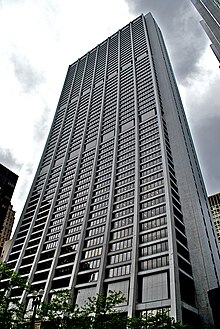Chase Manhattan Bank
|
The current logo, in use since 2007
|
|

|
|
| Subsidiary of JPMorgan Chase | |
| Industry | Banking |
| Predecessor | Bank of the Manhattan Company founded on September 1, 1799 |
| Founded | December 1, 2000 |
| Headquarters | Chicago, Illinois |
|
Key people
|
William C. Weldon (Chairman) |
| Products | Financial services |
| Revenue | US$ 71.651 billion (2014) |
| US$ 14.778 billion (2014) | |
| Total assets | US$ 2.6 trillion (2014) |
|
Number of employees
|
235,678 (2015) |
| Parent | JPMorgan Chase |
| Divisions | Retail Financial Services, Card Services, Commercial Banking |
| Website | Chase |
JPMorgan Chase Bank, N.A., doing business as Chase Bank, is a national bank that constitutes the consumer and commercial banking subsidiary of the multinational banking corporation JPMorgan Chase. The bank was known as Chase Manhattan Bank until it merged with J.P. Morgan & Co. in 2000. Chase Manhattan Bank was formed by the merger of the Chase National Bank and the Bank of the Manhattan Company in 1955. The bank is headquartered in Columbus, Ohio, since its merger with Bank One Corporation in 2004.The bank acquired the deposits and most assets of Washington Mutual.
Chase offers more than 5,100 branches and 16,100 ATM's nationwide. JPMorgan Chase has 235,678 employees (as of 2015) and operates in more than 100 countries. JPMorgan Chase currently has assets of approximately US$2.6 trillion.
JPMorgan Chase, through its Chase subsidiary, is one of the Big Four banks of the United States.
From September 1, 1799, to 1955, it was called The Bank of The Manhattan Company (New York); after a 1955 merger with the Chase National Bank (which existed separately from 1877 to 1954) it was called The Chase Manhattan Bank.
Chase traces its history back to the founding of The Manhattan Company by Aaron Burr on September 1, 1799, in a house at 40 Wall Street:
After an epidemic of yellow fever in 1798, during which coffins had been sold by itinerant vendors on street corners, Aaron Burr established the Manhattan Company, with the ostensible aim of bringing clean water to the city from the Bronx River but in fact designed as a front for the creation of New York's second bank, rivaling Alexander Hamilton's Bank of New York.
...
Wikipedia
